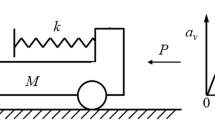Abstract
Throughout the vehicle crash event, the interactions between vehicle, occupant, restraint system (VOR) are complicated and highly non-linear. CAE and physical tests are the most widely used in vehicle passive safety development, but they can only be done with the detailed 3D model or physical samples. Often some design errors and imperfections are difficult to correct at that time, and a large amount of time will be needed. A restraint system concept design approach which based on single-degree-of-freedom occupant-vehicle model (SDOF) is proposed in this paper. The interactions between the restraint system parameters and the occupant responses in a crash are studied from the view of mechanics and energy. The discrete input and the iterative algorithm method are applied to the SDOF model to get the occupant responses quickly for arbitrary excitations (impact pulse) by MATLAB. By studying the relationships between the ridedown efficiency, the restraint stiffness, and the occupant response, the design principle of the restraint stiffness aiming to reduce occupant injury level during conceptual design is represented. Higher ridedown efficiency means more occupant energy absorbed by the vehicle, but the research result shows that higher ridedown efficiency does not mean lower occupant injury level. A proper restraint system design principle depends on two aspects. On one hand, the restraint system should lead to as high ridedown efficiency as possible, and at the same time, the restraint system should maximize use of the survival space to reduce the occupant deceleration level. As an example, an optimization of a passenger vehicle restraint system is designed by the concept design method above, and the final results are validated by MADYMO, which is the most widely used software in restraint system design, and the sled test. Consequently, a guideline and method for the occupant restraint system concept design is established in this paper.
Similar content being viewed by others
References
ZHANG Junyuan, LI Dongjun, BI Ying, et al. Optimization of vehicle side curtain airbag module based on computer aided engineer[J]. Chinese Journal of Mechanical Engineering, 2009, 22(4): 521–527.
ZHANG Junyuan, ZHANG Min, DING Rufang. Key techniques of multi-body modeling of occupant restraint system of vehicle side impart[J]. Chinese Journal of Mechanical Engineering, 2009, 19(3): 393–400.
OWENS C, HASSEL E V, UNGER M, et al. Frontal system optimization with MADYMO and mode frontier[G]. SAE Paper 2009-26-005.
VANGIPURAM R, LONG L. Truong H. et al, Parameter design based FEA correlation studies on automotive seat structures[G]. SAE Paper 2008-01-0241.
PARK S D, PYUN J K, CHOI B Y, et al. Seat common frame design optimization[G]. SAE Paper 2010-01-0390.
KHANNA S. Improving vehicle performance in offset deformable barrier crash as per ECE R94 via computer aided engineering[G]. SAE Paper 2009-01-0351.
KANG S, FEUSTEL J, BARNES E. Driver airbag linear impactor dynamic testing method and data analysis[G]. SAE Paper 2006-01-1436.
EVANS N C, FURTON L M, COK D A. Occupant energy management technique for restraint system analysis and design — theory and validation[G]. SAE Paper 922082, 1992.
BONELLO K J. Occupant energy management technique for restraint system analysis and design Understanding the physics of the system[G]. SAE Paper 922083, 1992.
HUANG M, LAYA J, LOO M. A study on ride-down efficiency and occupant responses in high speed crash test[G]. SAE Paper 950656.
MACMILLAN R H. Dynamics of vehicle collisions[M]. London, UK: Inderscience Enterprises Ltd., 2002.
ZHANG Xuerong, LIU Xuejun, CHEN Xiaodong, et al. Development and test validation of safety belt restraint system for frontal impact[J]. Automotive Engineering, 2007, 29(12): 1 055–1 058.
SAUNDERS J, STASHNY A, WIACEK C. Relationship between frontal stiffness and occupant compartment intrusion in frontal crash tests[G]. SAE Paper 2008-01-0815
ROSE N A, STEPHEN J, FENTON, et al. Crush and conservation of energy analysis: toward a consistent methodology[G]. SAE Paper 2005-01-1200.
WUJIANPING, BLKHUL S, GUY S, et al. An impact pulse-restraint energy relationship and its applications[G]. SAE Paper 2003-01050, 2003.
PATHARE R, LOKHANDE A, VOGEL G, et al. Material model development of an energy absorbing foam for occupant safety[G]. SAE Paper 2009-26-088.
Author information
Authors and Affiliations
Corresponding author
Additional information
This project is supported by National Natural Science Foundation of China (Grant No. 51075180), and Open Foundation of State Key Laboratory of Vehicle NVH and Safety Technology of China (Grant No. NVHSKL-201013)
ZHANG Junyuan, PhD, born in 1965, is a full-time professor at Jilin University, China. She received her BSc, MSc and PhD degrees in Automobile Engineering from Jilin University, China, in 1985, 1990, and 2003, respectively. She worked as an engineer at R&D Centre FAW, China, from 1985 to 1995, and visited to Ford Motor Co., U.S., in 1998. Her research interests include Auto-Body design and vehicle passive safety.
MA Yue, born in 1988, received her BSc in Automotive Engineering from Jilin University, China. At present, she is an MSc candidate at Jilin University, China. Her research focused on vehicle passive safety, and restraint system design and optimization methods particularly.
CHEN Chao, born in 1985, received his BSc and MSc degrees in Automotive Engineering from Jilin University, China, in 2008 and 2011, respectively. His research focused on vehicle passive safety.
ZHANG Yan, born in 1985, received her BSc and MSc degrees in Automotive Engineering from Jilin University, China, in 2007 and 2009, respectively. She is engaged in vehicle passive safety.
Rights and permissions
About this article
Cite this article
Zhang, J., Ma, Y., Chen, C. et al. Design and optimization for the occupant restraint system of vehicle based on a single freedom model. Chin. J. Mech. Eng. 26, 492–497 (2013). https://doi.org/10.3901/CJME.2013.03.492
Received:
Revised:
Accepted:
Published:
Issue Date:
DOI: https://doi.org/10.3901/CJME.2013.03.492




